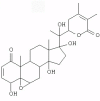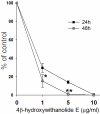4beta-Hydroxywithanolide E from Physalis peruviana (golden berry) inhibits growth of human lung cancer cells through DNA damage, apoptosis and G2/M arrest
- PMID: 20167063
- PMCID: PMC2830937
- DOI: 10.1186/1471-2407-10-46
4beta-Hydroxywithanolide E from Physalis peruviana (golden berry) inhibits growth of human lung cancer cells through DNA damage, apoptosis and G2/M arrest
Abstract
Background: The crude extract of the fruit bearing plant, Physalis peruviana (golden berry), demonstrated anti-hepatoma and anti-inflammatory activities. However, the cellular mechanism involved in this process is still unknown.
Methods: Herein, we isolated the main pure compound, 4beta-Hydroxywithanolide (4betaHWE) derived from golden berries, and investigated its antiproliferative effect on a human lung cancer cell line (H1299) using survival, cell cycle, and apoptosis analyses. An alkaline comet-nuclear extract (NE) assay was used to evaluate the DNA damage due to the drug.
Results: It was shown that DNA damage was significantly induced by 1, 5, and 10 microg/mL 4betaHWE for 2 h in a dose-dependent manner (p < 0.005). A trypan blue exclusion assay showed that the proliferation of cells was inhibited by 4betaHWE in both dose- and time-dependent manners (p < 0.05 and 0.001 for 24 and 48 h, respectively). The half maximal inhibitory concentrations (IC50) of 4betaHWE in H1299 cells for 24 and 48 h were 0.6 and 0.71 microg/mL, respectively, suggesting it could be a potential therapeutic agent against lung cancer. In a flow cytometric analysis, 4betaHWE produced cell cycle perturbation in the form of sub-G1 accumulation and slight arrest at the G2/M phase with 1 microg/mL for 12 and 24 h, respectively. Using flow cytometric and annexin V/propidium iodide immunofluorescence double-staining techniques, these phenomena were proven to be apoptosis and complete G2/M arrest for H1299 cells treated with 5 microg/mL for 24 h.
Conclusions: In this study, we demonstrated that golden berry-derived 4betaHWE is a potential DNA-damaging and chemotherapeutic agent against lung cancer.
Figures





Similar articles
-
Golden berry-derived 4β-hydroxywithanolide E for selectively killing oral cancer cells by generating ROS, DNA damage, and apoptotic pathways.PLoS One. 2013 May 21;8(5):e64739. doi: 10.1371/journal.pone.0064739. Print 2013. PLoS One. 2013. PMID: 23705007 Free PMC article.
-
Physalis peruviana-Derived 4β-Hydroxywithanolide E, a Novel Antagonist of Wnt Signaling, Inhibits Colorectal Cancer In Vitro and In Vivo.Molecules. 2019 Mar 22;24(6):1146. doi: 10.3390/molecules24061146. Molecules. 2019. PMID: 30909473 Free PMC article.
-
4β-Hydroxywithanolide E isolated from Physalis pruinosa calyx decreases inflammatory responses by inhibiting the NF-κB signaling in diabetic mouse adipose tissue.Int J Obes (Lond). 2014 Nov;38(11):1432-9. doi: 10.1038/ijo.2014.33. Epub 2014 Feb 25. Int J Obes (Lond). 2014. PMID: 24566854
-
Induction of cell cycle arrest and apoptosis with downregulation of Hsp90 client proteins and histone modification by 4β-hydroxywithanolide E isolated from Physalis peruviana.Mol Nutr Food Res. 2016 Jun;60(6):1482-500. doi: 10.1002/mnfr.201500977. Epub 2016 May 11. Mol Nutr Food Res. 2016. PMID: 27006100
-
Withanolides, the hidden gem in Physalis minima: A mini review on their anti-inflammatory, anti-neuroinflammatory and anti-cancer effects.Food Chem. 2022 May 30;377:132002. doi: 10.1016/j.foodchem.2021.132002. Epub 2022 Jan 3. Food Chem. 2022. PMID: 35033733 Review.
Cited by
-
Screening of promising chemotherapeutic candidates from plants extracts.J Nat Med. 2016 Jul;70(3):335-60. doi: 10.1007/s11418-016-0992-2. Epub 2016 Apr 16. J Nat Med. 2016. PMID: 27086008 Free PMC article. Review.
-
Obtusilactone A and (-)-sesamin induce apoptosis in human lung cancer cells by inhibiting mitochondrial Lon protease and activating DNA damage checkpoints.Cancer Sci. 2010 Dec;101(12):2612-20. doi: 10.1111/j.1349-7006.2010.01701.x. Cancer Sci. 2010. PMID: 21077998 Free PMC article.
-
Acute and Subchronic Toxic Effects of the Fruits of Physalis peruviana L.Evid Based Complement Alternat Med. 2013;2013:707285. doi: 10.1155/2013/707285. Epub 2013 Nov 28. Evid Based Complement Alternat Med. 2013. PMID: 24369482 Free PMC article.
-
Bioactive Steroids with Methyl Ester Group in the Side Chain from a Reef Soft Coral Sinularia brassica Cultured in a Tank.Mar Drugs. 2017 Sep 1;15(9):280. doi: 10.3390/md15090280. Mar Drugs. 2017. PMID: 28862648 Free PMC article.
-
Lentivirus-delivered ZEB-1 small interfering RNA inhibits lung adenocarcinoma cell growth in vitro and in vivo.J Cancer Res Clin Oncol. 2012 Aug;138(8):1329-38. doi: 10.1007/s00432-012-1206-2. Epub 2012 Apr 6. J Cancer Res Clin Oncol. 2012. PMID: 22481253 Free PMC article.
References
Publication types
MeSH terms
Substances
LinkOut - more resources
Full Text Sources
Other Literature Sources
Medical

